Corot at SBMA
Corot in California Brings Together Important Works by French Landscape Artist Jean-Baptiste-Camille Corot
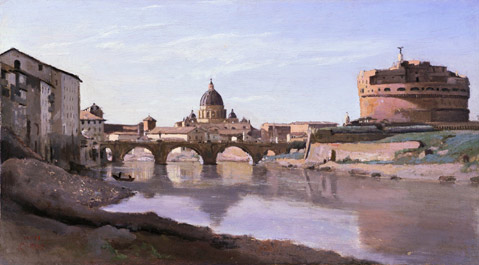
Jean-Baptiste-Camille Corot, amiable patriarch of modern landscape painting, gets a full and rapt appreciation in a new exhibit of work held by collections in California. UCSB professor of the history of art and Santa Barbara Museum of Art consulting curator Bruce Robertson has gathered two dozen examples of the 19th-century French painter’s most stimulating work and hung them in the museum’s Emmons and Romberg galleries so as to create the effect of a major exhibition on a modest scale-a mini-blockbuster ushering Corot into the new century. The last comprehensive retrospective of the painter’s work was at the Metropolitan Museum of Art in New York in fall 1996. Corot, whose prolific work also was copied widely, benefits from the tight focus and high quality on display in Corot in California.
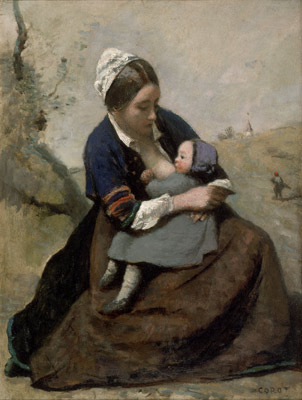
Although Corot prided himself on his subtle tonality, the stereotype of “Corot gray” canvases cannot withstand direct exposure to the works themselves. Masterworks like his “View of Rome: The Bridge and Castel Sant’Angelo with the Cupola of St. Peter’s” of 1826-28 are among the most prescient and timeless images in Western art, reaching as they do back to classical Rome and forward toward the palimpsests of the contemporary urban environment. Whether depicting his beloved trees or the manifold geometric shapes of a village skyline, Corot consistently captures both the logic and the spirit of place in his art.
I spoke with Bruce Robertson last week about his choices and motivations for mounting the exhibit.
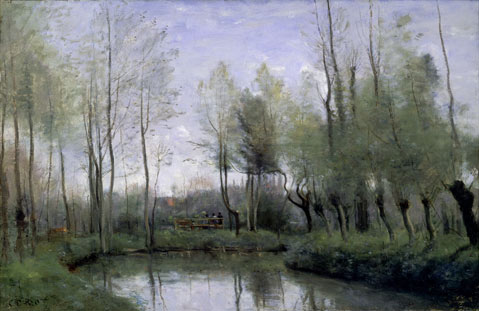
How did this show come together? The show came about through reciprocal loans among California museums. The SBMA owns a really good Berthe Morisot that gets requested all the time, and the Fine Arts Museums of San Francisco wanted to borrow it for a show it was doing, so that got us thinking about what we might ask for in exchange. We don’t lend the Morisot internationally, but in this case it was within California, and the great thing is it gave us a reciprocal arrangement where they were willing to grant us anything we wanted from their collection, which is large and excellent.
If you could have borrowed anything, why did you choose Corot? We wanted to do something for the public that would reflect well on what we have, and what we have access to within the community here. So we decided to show the view of Rome from the Legion of Honor, and create a Corot in California show to demonstrate the way the artist has been collected here for quite a long time-since the 19th century.
Are these all the Corots in California? No. Corot is well-represented in some staggeringly beautiful California collections. There are others-ones that we did not get-that are every bit as interesting, in places like the Huntington and the Norton Simon. Even though we got some amazing things-not only from the Fine Arts Museums, but also from the Hammer and the Getty-there are still just as many good Corots in California outside this show as there are in it. So from that point of view, maybe this is an introduction to Corot in California, something to get people to go look for the rest of them.
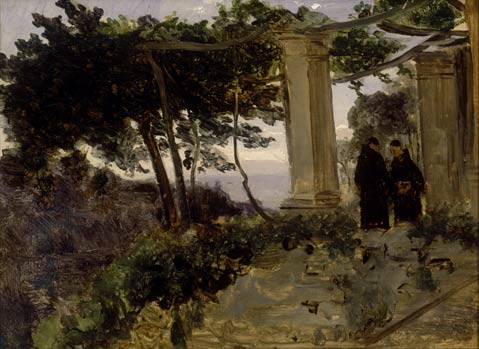
You mentioned that some of the pieces are from Santa Barbara collections. Could you say more about that? Yes, there are pieces from a group of really beautiful Italian oil sketches that were lent from a Santa Barbara collection, and there are also drawings from another collection held here. The Italian oil sketches are particularly interesting. Corot was part of a community of artists who went to Italy to paint in the 19th century. It’s not like he invented it [going to Italy and sketching outdoors], but nevertheless the purity of perception and touch that appears in his Italian work is unequaled. Corot belongs to a small group of French artists spread across history-Chardin and Manet are two other examples-who have this ability to get things absolutely, almost inexpressibly right. You look at their best work and think, “This is it; everything is exactly as it should be,” but there’s nothing to point at, and almost nothing to say; it’s just perfect.
Are any of these paintings narratives of history or myth? Corot did not really paint history painting, or allegories, or even simple naturalistic plein air landscapes. His genre was a kind of mediated poetic reverie of the landscape. He included his direct impression of nature on the spot, and then added to it from his photographic memory in the studio. If he did include figures, they were treated as realities, and to that extent demythologized. His primary subject is the atmosphere. Every leaf and branch was as present to him when he was in his studio as it would be if he were out in nature, because he was such a persistent, habitual observer.
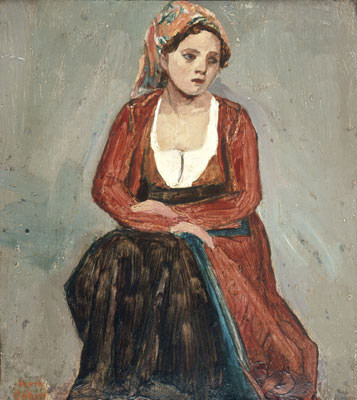
What can you point out about these compositions that give them their genius? What I look for in Corot’s work are things like the rhythms he creates with trees as vertical elements. You can even find evidence that he is working with the golden mean; only he is finding it in the negative space between the trees in its relation to the respective widths of their trunks [Robertson demonstrates by pointing to painting]. At first his composition can seem incidental or merely representational, but then it provokes an infinite and profound response, like music.
Is there a blockbuster salon painting in the show? “Morning” from 1865 is the most like a salon painting, although I don’t believe it was in the actual Salon. It’s the one with the cupids.
Are there any special provenance notes that are interesting to know about? Degas owned the figure study of the second Italian girl at one point.
Why are there so many Corots in California? What is the connection? Corot was actively collected by both the old and new wealth in America, and that collecting is still active. So, what is it about Corot? The American love of landscape goes a long way toward explaining it, because there is no purer landscape painter than Corot. There’s also the fact that he was well-known. He got reproduced early on, and in many ways. He loved drawing, and his drawings were reproduced frequently. The cliche-verre pieces in the show are early photomechanical reproductions of his drawings. He loved working, so there were “entry level” prints right from the beginning of his success, and that’s part of the story of his reaching California so early. But you can say that about so many artists, even someone like Jasper Johns. As soon as they hit a certain price point with the paintings, out come the prints.
4•1•1
Corot in California will be on display at the Santa Barbara Museum of Art through October 11. For more information, call 963-4364 or visit sbmuseart.org.



